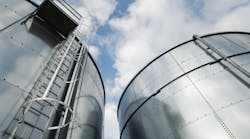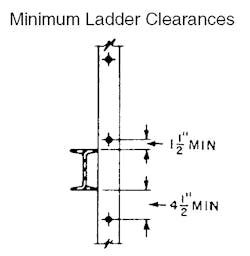It’s common practice to use a vertical ladder on a vessel or tank to support lighting and instrument conduit, but there are some important rules to follow when doing so. First, the ladder has to be substantial enough to accept the weight of the conduit and support hardware. Second, adequate toe space must be maintained behind the ladder so personnel will not step on the conduit or supports or catch their toes on these components while climbing the ladder.
In the U.S., OSHA CFR 29, Part 1910, Subpart D, Section 1910.27(c)(4) addresses toe clearance behind ladder rungs. As a general rule, 7 in. of free and clear space must be left between the backside of the ladder and any conduit or other obstruction such as conduit support materials. Where it is impossible to maintain 7 in. of clear space, the Figure (reprinted from OSHA.gov) illustrates an acceptable variance.
To access all of the OSHA regulations, visit https://www.osha.gov/law-regs.html.
© 2014 Fluor Corporation. All Rights Reserved.




